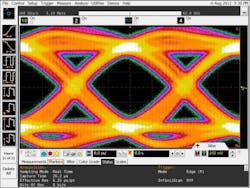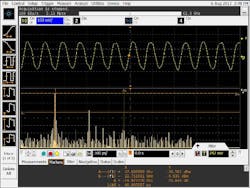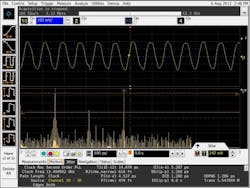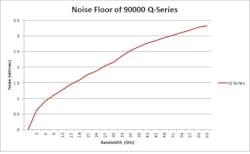Real-time oscilloscope analysis for 28/32-Gbps SerDes measurements
With the recent bandwidth breakthroughs in real-time oscilloscopes, measurements that previously could only be achieved using a sampling oscilloscope now can be handled by real-time oscilloscopes. Real-time oscilloscopes have not only broken the 60-GHz bandwidth barrier, they continue to improve in their measurement performance. While their noise and jitter levels still aren’t as low as those of a sampling oscilloscope with a precision time base, they have narrowed what was once a large signal integrity gap.
As a result, oscilloscope users that previously would only use sampling oscilloscopes now should also consider a real-time oscilloscope. Real-time oscilloscopes offer the advantage of making measurements in a single acquisition and can capture milliseconds of data in that single acquisition, providing greater flexibility for debugging. The disadvantage tends to be cost (real-time oscilloscopes can be more than twice as expensive as sampling oscilloscopes) and the slightly worse signal integrity (i.e., higher noise and jitter).
With these tradeoffs in mind, many designers feel that the advantages of a real-time oscilloscope are very appealing, especially when designing with 28- and 32-Gbps signals (Figure 1). Choosing a real-time oscilloscope can be the right decision for these applications; however, it is important to know how to properly use these scopes to maximize design margins in 28- and 32-Gbps designs.
Bandwidth
Probably the most important characteristic of an oscilloscope is its bandwidth. To properly depict an edge, you must have the right amount of bandwidth. One rule of thumb for many years has been that you need to capture the fifth harmonic to have enough bandwidth on an oscilloscope. Of course, for 28- and 32-Gbps signals this would mean that you would need at least 70 GHz of bandwidth.
The reality is that the fifth harmonic rule of thumb does not apply for 28- and 32-Gbps signals. What is interesting about these high-speed SerDes signals is that they tend to have slower rise times. Slower rise times mean that there is less high-frequency content. Again, enough oscilloscope bandwidth is needed to properly digitize the rise time of the signal. If a signal has 40-ps (10/90) rise time then only 16 GHz of bandwidth is needed. In the case of a 40-ps rise time, the first harmonic is all the frequency content that exists. Figure 2 shows the high-frequency content of a typical 25-Gbps signal.
Of course, not all 28- and 32-Gbps signals have rise times as slow as 40 ps, which makes having more bandwidth important. For instance, a rise time of 20 ps could have harmonic content to the third harmonic. This would require a bandwidth of 50 GHz for the real-time oscilloscope. As rise times increase in speed to sub-10 ps, the fifth harmonic becomes a valid rule of thumb once again, as harmonic content would then be available to greater than 70 GHz. Figure 3 depicts a 15-ps rise time on a 28 Gbps device; notice that the frequency content of the signal reaches higher than 40 GHz.
It should be noted that one of the demands for high-speed devices is to minimize power; unfortunately, to drive a device to sub-10 ps requires very high power. For 28- and 32-Gbps signals, low power overrides faster rise times, which means 50 GHz of bandwidth is more than enough bandwidth for testing most high-speed SerDes devices.
Noise floor
As mentioned in the introduction, sampling oscilloscopes will have a lower noise floor than real-time oscilloscopes; depending on the full scale setting of the device, the difference can be significant. As a result, the noise floor is extremely important when using a real-time oscilloscope. In many ways, noise floor is nearly as important as the bandwidth of the oscilloscope. Oscilloscope noise erodes margins; the more noise that the oscilloscope has, the more the oscilloscope could influence the measurement.
As data rates continue to shrink, the unit interval of the signal shrinks as well, which means that there are smaller margins. Oscilloscope users can ill afford to have these margins eroded due to instrument noise. In fact, if the oscilloscope noise exceeds the noise of the target system, it will become the principal source of the jitter and eye closing. Designers who spend much of their time ensuring their chips are fully functional do not want their measurements and decisions to be based on the oscilloscope noise rather than the design itself. Clearly, choosing a real-time oscilloscope with the right mix of bandwidth and low noise must be a key part of an oscilloscope purchase decision.
Once making 28G measurements, it is possible to improve the noise floor of the oscilloscope by using the correct amount of bandwidth. Due to high-frequency noise, as oscilloscope bandwidths increase, so does the noise (see Figure 4). As discussed earlier, typically 28- and 32-Gbps signals have slow rise times and very little high-frequency energy above 30 GHz. Oscilloscopes also have a feature which is known as bandwidth limiting, where you can choose the bandwidth of the oscilloscope. By correctly choosing the bandwidth on your oscilloscope, excess noise can be eliminated, increasing design margins.
Jitter measurement floor
Typically noise will affect the height of the eye. But for 28- and 32-Gbps signals, many key specifications revolve around jitter. In most cases the jitter must be measured on very long patterns such as PRBS23 and PRBS31. Measuring jitter specifications such as total jitter, random jitter, and deterministic jitter with long patterns is difficult for high-performance oscilloscopes unless they are properly designed.
High-performance oscilloscopes have two key hardware specifications that contribute to 28/32-Gbps measurements. The first is known as the sample clock jitter and the second is known as the jitter measurement floor. Sample clock jitter is often known as the intrinsic jitter; it shows how good an oscilloscope clocking system is at aligning samples. Each high-performance oscilloscope has an internal clock that aligns the scope’s data points. The internal clock ties the ADC to the sampler to the memory controller.
The sample clock jitter contributes to the jitter measurement floor. The internal clock of the oscilloscope is stressed with long patterns to properly separate random from deterministic jitter. The oscilloscope requires very deep memory and deep memory stresses the internal clock. The stressed internal clock can drift and thus misplace important samples. This misplacement of samples causes increased random jitter, not from the designer’s device, but rather from the oscilloscope.
Oscilloscope designers must use extremely accurate clocks that maintain low sample clock jitter, even when stressed by deep memory.
Deep memory
As just implied, to measure jitter on long patterns accurately requires more memory. The deeper the oscilloscope memory and more accurate the oscilloscope sample clock, the more accurate the jitter decomposition will be for PRBS23 and PRBS31 patterns.
A PRBS23 pattern has 8.4 million bits in its pattern; at 28 Gbps and 160 GS/s, an oscilloscope must have at least 50 MPts of data to capture a single pattern. However, it is better to acquire more than one pattern in a single acquisition, which is where deeper memory means higher accuracy. Fortunately, real-time oscilloscopes capable of handling 2 GPts of data are now on the market.
Analysis tools
In recent years, real-time oscilloscopes have begun including more advanced analysis tools as part of their user interface or as optional additions. These tools include the ability to separate jitter, de-embed, equalize a signal, and look at a Fast Fourier Transform (FFT). The tools make measurements for 28-Gbps signals possible. For example, some of the measurements needed for the 28G Common Electrical Interface (CEI) include baud rate, rise time, fall time, output differential voltage, output common mode voltage, uncorrelated unbounded Gaussian jitter, total jitter, and duty cycle distortion. All of these measurements can be performed by a real-time oscilloscope with the right tools.
Just making the measurements may not be enough, however. As mentioned earlier, one of the dilemmas of a real-time oscilloscope is that it has higher noise than a sampling oscilloscope. One tool that is becoming increasingly popular among the real-time oscilloscope vendors is the ability to calibrate out oscilloscope noise and jitter. Another key tool is the ability to fix the random jitter in jitter measurements. Fixed random jitter means that regardless of the rise-time speed, which influences the amount of scope-induced jitter, the increased oscilloscope jitter can be ignored. Fixed random jitter also makes debugging cross-talk situations possible.
Conclusion
Real-time oscilloscopes can be effective tools for measuring 28- and 32-Gbps devices. It is important to understand the tradeoffs of a real-time oscilloscope that can make the most accurate measurements. When used properly a real-time oscilloscope will accurately depict the device and offer the flexibility needed in a single acquisition system.
Brig Asay is product manager, high performance oscilloscopes at Agilent Technologies.



